
- We will send in 10–14 business days.
- Author: Selvaraj Saravanan
- Publisher: Partridge India
- ISBN-10: 1482842599
- ISBN-13: 9781482842593
- Format: 15.2 x 22.9 x 1.7 cm, softcover
- Language: English
- SAVE -10% with code: EXTRA
Reviews
Description
Signal processing can be broadly defined as the application of analog or digital techniques to improve the utility of a data stream. Analog techniques are applied to a data stream embodied as a time-varying electrical signal. While in the digital domain, the data are represented as an array of numbers. A video signal is represented as a sequence of frames of pixels. There exists vast amount of redundant information that can be eliminated with video compression technology. So that its transmission and storage becomes more efficient. Video and image compression is a complex and extensive subject, and this book keeps an offered limited focus, concentrating on the standards themselves and on video coding concepts that directly underpin the standards. The leading contenders are the International Standards known as MPEG-4 Visual and H.264. H.264/AVC, the result of the collaboration between the ISO/IEC Moving Picture Experts Group and the ITU-T Video Coding Experts Group, is the latest standard for video coding. H.264/AVC provides gains in compression efficiency of up to 50% over a wide range of bit rates and video resolutions compared to previous standards. There is therefore a need to develop low complexity implementations of H.264/AVC that offer the performance and flexibility advantages of the standard without an excessive computational cost.
EXTRA 10 % discount with code: EXTRA
The promotion ends in 13d.23:36:44
The discount code is valid when purchasing from 10 €. Discounts do not stack.
- Author: Selvaraj Saravanan
- Publisher: Partridge India
- ISBN-10: 1482842599
- ISBN-13: 9781482842593
- Format: 15.2 x 22.9 x 1.7 cm, softcover
- Language: English English
Signal processing can be broadly defined as the application of analog or digital techniques to improve the utility of a data stream. Analog techniques are applied to a data stream embodied as a time-varying electrical signal. While in the digital domain, the data are represented as an array of numbers. A video signal is represented as a sequence of frames of pixels. There exists vast amount of redundant information that can be eliminated with video compression technology. So that its transmission and storage becomes more efficient. Video and image compression is a complex and extensive subject, and this book keeps an offered limited focus, concentrating on the standards themselves and on video coding concepts that directly underpin the standards. The leading contenders are the International Standards known as MPEG-4 Visual and H.264. H.264/AVC, the result of the collaboration between the ISO/IEC Moving Picture Experts Group and the ITU-T Video Coding Experts Group, is the latest standard for video coding. H.264/AVC provides gains in compression efficiency of up to 50% over a wide range of bit rates and video resolutions compared to previous standards. There is therefore a need to develop low complexity implementations of H.264/AVC that offer the performance and flexibility advantages of the standard without an excessive computational cost.


Reviews